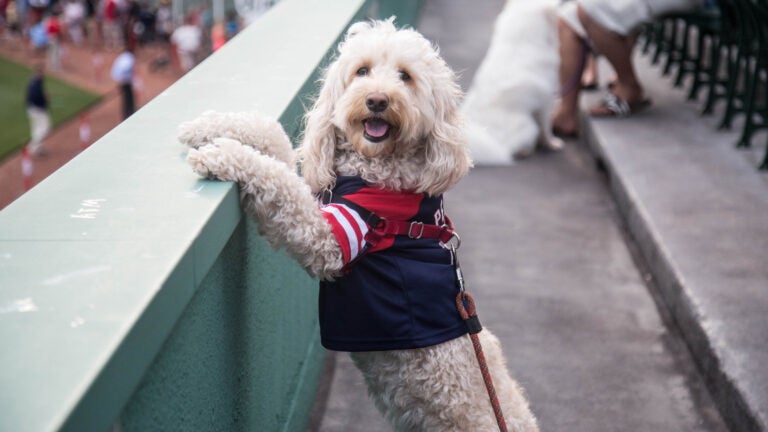Dog flu has arrived in Massachusetts. Here’s what you need to know.
“Don’t panic, just take precautions.”

Dog flu has officially arrived in Massachusetts. The MSPCA’s Angell Animal Medical Center announced Thursday that it diagnosed and treated a 4-month-old poodle for the virus. The pup was brought in on Aug. 12 with a “hacking cough” and a fever, and the medical center said the animal hadn’t traveled to any of the states — New York, Connecticut, Pennsylvania, Michigan, Wisconsin, and California — experiencing an outbreak of canine flu. Angell spokesman Rob Halpin said it is the medical center’s second-ever confirmed case of the virus. “The dog was released after two days,” Halpin said. “It’s unclear at this stage if the dog was suffering from the more severe and highly contagious H3N2 strain as too little virus could be extracted to confirm the exact strain.”Angell officials are urging dog owners to talk with their veterinarians about vaccinating their four-legged companions to help protect against the illness. “Don’t panic, just take precautions,” Dr. Virginia Sinnott, a veterinarian at Angell Animal Medical Center, said. We spoke with Sinnott to learn more about the symptoms of dog flu and how worried pet owners in Massachusetts should be about the arrival of the virus in the state.
How concerned should dog owners be that dog flu is in Massachusetts?
Sinnott said it’s “very concerning” that the virus has showed up in the Bay State.“The most contagious form of the flu can spread with just nose-to-nose contact, so when your dog is sniffing a friend on the street that they meet in passing, they can transmit influenza if that dog has the virus,” Sinnott said about the H3N2 strain of the illness. “The reason it’s so contagious is that dogs can [have the] virus for up to a couple of weeks before they actually feel sick once they’ve been exposed, so that’s why it spreads very quickly.”The other strain of the illness, H3N8, is typically associated with racetracks and kennels, she said. If your dog does get the flu, she said it’s far more likely to be a “nuisance” than it is to be life-threatening. “In very rare cases — usually in the very young and the very old or dogs with respiratory dysfunction to begin with — they can get pneumonia,” Sinnott said. She estimated that less than 10 percent of dog flu cases require hospitalization, let alone become life-threatening. “It’s very contagious, but it’s very rarely life-threatening,” the doctor said. “So if we just take precautions, I think we can prevent an outbreak.”
How is the virus transmitted?
Nose-to-nose contact isn’t the only way the virus can be spread from pup to pup, according to Sinnott. Canine flu can also be spread by respiratory secretions on objects, and she said the virus can exist in the environment for 24 to 48 hours depending on the surface it’s on. “It is unique in that it is very contagious,” she said. “If you’re in the neighborhood of someone that has it, even if you just walk by the dog park and the dog happens to cough through the fence, your dog could get it.” But, she said, the virus is relatively easy to kill. Wiping down cages in a veterinary environment or kennel and washing bedding and fabrics will do the job.“If it’s really here, your dog is very likely to get it if you go to dog parks or you participate in doggie daycare,” she said. “And that’s no one’s fault — that’s just because it’s so contagious.”Dogs who have been diagnosed with the flu should be quarantined for a month from the time the animal first started showing symptoms, she said, to help prevent spreading it further.“We’re doing enhanced cleaning to make sure that every vertical surface that a dog would touch … is getting cleaned regularly,” Sinnott said. “And the same thing should be true for other places.”
What are the symptoms?
Most illnesses in dogs will make your canine companion feel a little lethargic — they might not want to eat or run to greet you at the door. So, if your pup is laying around, it could be hint that they’re feeling sick.With canine flu, be sure to look out for coughing, Sinnott said. “The most specific thing we’re seeing with influenza is that it’s very much like kennel cough. They cough,” she said. If your pup starts to cough, she recommends contacting your vet, especially if you know it has come into contact with other dogs.“It’s important when you contact your vet to say you’re concerned about something contagious, so we’re not spreading it around in the waiting room [while] waiting for your exam,” Sinnott said. Once diagnosed, she said it can take several weeks to be rid of the virus. “The treatment is symptomatic, meaning we treat the cough so that they can sleep and their immune system has to deal with the virus,” the vet said. “So it’s easy to make them comfortable, but hard to make it go away.”
What can people do to prevent their dog from getting sick?
Given a local pup has been diagnosed with the virus — and likely picked it up somewhere in Boston — Sinnott said she recommends getting your dog vaccinated or at least talking to your vet about whether your pet is a candidate for the flu vaccine.There’s always a risk of reaction to the injection, but she said it’s a “very low-risk vaccine.” It won’t prevent every infection, but it reduces the symptoms for your dog if it does get the flu.“If your dog goes to doggie daycare every day or if you go to dog parks every day … where there’s lots of contact with other dogs, it’s important to talk to your vet about it,” Sinnott said. “Most dogs are a good candidate. The only ones who wouldn’t be are those who are sort of sick, but you should have the conversation.”Another option to help prevent your dog contracting the illness is to avoid dog parks, but the Angell vet said pet owners can factor in how important interactions with other pups is to your dog before cutting out the routine.“We’ve only had one case, so if you really think your dog’s life is affected by not doing dog-to-dog interaction, then know that there’s a risk but you can certainly take it,” Sinnott said. “If you can avoid it, if it’s not that big a deal, if it’s the cherry on top of the sundae of your dog’s day, then maybe not. Maybe let’s take a month off and see what happens.”
Is dog flu seasonal?
The H3N2 strain of canine flu arrived in the United States in 2015, according to Sinnott, so it hasn’t yet become seasonal. “Right now, it’s sporadic and travels with animals from region to region,” she said. “It may become seasonal at some point, but for right now, it is not seasonal.”For that reason, Sinnott advised dog owners to “keep your ear to the ground” and, if your traveling with your pup, find out if there’s been an outbreak where you’re heading or if a case has been confirmed in your neighborhood. “They do usually pass,” she said of outbreaks. “The one in New York City lasted about two to three months. And that can be attributable to some commendable efforts by veterinarians testing, vaccinating, and then doggie daycares and kennels requiring proof that the dog doesn’t have flu. Tight control. But then again, it does run its course over time.”







